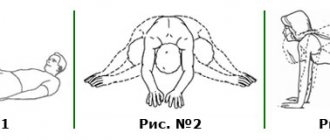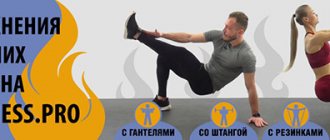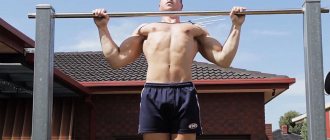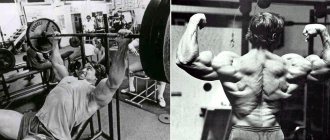Explosive strength in bodybuilding is not an important quality, except that during periods of stagnation caused by the body’s adaptation to stress, explosive exercises are able to overcome the so-called “growth plateau.” But in other sports, this ability is the decisive factor leading to victory! This indicator is needed in almost every sport. Athletes involved in any type of martial arts, track and field athletes (sprinters), participants in team sports, weightlifters, powerlifters, crossfitters, fencers, tennis players and many other athletes cannot do without explosive power. This ability allows you to achieve victory through one dash, throw, lightning and crushing blow!
What is explosive force
Explosive strength is the ability to mobilize all the body’s energy reserves and direct them to perform great efforts in the shortest possible time. During explosive movements, the muscles contract instantly. For example, before a jump, an athlete squats deeply, stretching the muscles, after which he makes a jerk, during which the so-called reactive movement occurs, the muscles instantly contract and direct him in the desired direction with maximum energy.
Muscle reactivity and explosive strength develop parallel to each other. When performing explosive movements, concentrated muscle tension occurs. But if reactive ability develops only with maximum stretching of the muscle fibers, as was described with the example of jumping, then explosive strength can be trained without stretching the fibers. For example, a boxer's punch when he throws a standing punch.
Why develop explosive muscle power and who benefits from it?
Who needs it and why to develop it was partially described at the beginning of this article. In many sports, explosive strength plays a decisive role in achieving victory, and in some, like bodybuilding, it plays an indirect role, but sometimes bodybuilders cannot do without its development.
- Explosive strength plays a key role in weightlifting . Almost all exercises - snatch, clean and jerk, barbell clean - are performed with an instant squat and release and, by the way, the faster the transition from squatting to pressing a heavy weight (barbell), the better its performance will be.
- But in powerlifting, explosive strength, although important, does not play a key role. To perform exercises, powerlifters train mainly pure strength.
Working with your weight
This work is done quite quickly, done about 2-3 times a week. Four exercises are performed at maximum speed, between sets there is a rest of about 20 seconds with mandatory relaxation of the arms.
1). 10 quick push-ups with your fists. Executes at maximum speed.
2). 10 explosive push-ups on fists with hands touching chest.
3). 10 simple push-ups with clap.
4). Five explosive push-ups on each hand, switching hands after one repetition.
Recommendations for training for explosive strength
There aren't many recommendations.
- Firstly, exercises to develop explosive strength should be performed only after a good, effective warm-up, when the muscles have become toned and warmed up.
- Secondly, you should not load sports equipment with heavy weight or immediately set high goals for yourself, for example, jumping onto a one and a half meter platform from a standing position. Start with a low-height platform and gradually move to higher ones.
- Third, until your muscles have adapted to explosive loads, it is best to focus your training on bodyweight exercises. Subsequently, exercises with your own weight can be complicated with small dumbbells or weights.
For beginners , exercises such as all types of burpees, jumping with alternating legs or air lunges, push-ups, and ball throws are suitable.
By following these simple recommendations, you can minimize the risk of injury and take the right path to achieving your goal.
What is she like?
This muscle characteristic should be one of the first places for an athlete. A boxer who is good with it, for example, will have many more knockout victories than one who has less explosive power. Endurance also needs to be developed, because otherwise your muscles will get tired very quickly after such high loads and work. Next, let's look at the main types of training.
Number of repetitions and approaches
Training to develop explosive strength should consist of a set of three to six exercises. The number of approaches and repetitions will depend on the training of the athlete and the complexity of the exercises that he will perform.
- If you do light exercises , such as those performed without weights, you can do two to four sets of 10 repetitions.
- If you perform heavy exercises , such as a snatch, jumping on a weighted stand, or some complex plyometric push-ups, then the number of approaches can be increased from three to seven and performed two to three repetitions.
As an example, consider circuit training for trained athletes.
In it, one circle consists of three exercises. They must be performed one after another with a break of ten seconds.
- Exit by force.
- Ten second break.
- Jumping on the stand.
- Ten second break.
- Throwing out the ball.
- Ten second break.
After a 90 second rest, you can perform the next circuit.
Exercises to develop explosive strength
Below we will present exercises that develop explosive strength, including exercises for both entry-level athletes and experienced athletes.
Falling from a height followed by a jump
From a height (bench) the athlete falls down. During the fall, kinetic energy accumulates, and during landing, an eccentric muscle contraction occurs, which is replaced by a concentric one - jumping up.
To prepare for this exercise, you can perform jumps on steps, from foot to foot, and in length.
Barbell Chest Raise
When holding the barbell vertically with straight arms, an eccentric contraction of the muscle fibers occurs, and at the moment of the jerk, after which the barbell moves to the chest, the muscles instantly switch from eccentric contraction to concentric.
This exercise should be performed with light weight. 50% of one repetition maximum is considered optimal.
Barbell snatch row
Just like the barbell clean, this exercise is performed as quickly as possible. In this exercise, there is a short pause between the pull and the pull. Thanks to the pause, inertia is reduced and the load during detonation increases. The optimal weight for performing this exercise is 50% of the maximum.
Thrusters
The barbell is placed in front of you on your shoulders, your elbows rise as high as possible. Thrusters are performed in this way: first, a squat is performed (an eccentric contraction occurs), after which the legs are straightened with an explosive movement. At the same time as you lift, you need to push the barbell up above your head.
Plyometric push-ups
There are many varieties of push-ups of this type. They are performed with jumping, clapping, lifting after stretching the muscles. You can choose just one, or you can make a whole complex.
Burpee
The simplest version of burpees is push-ups followed by jumping. But, like plyometric push-ups, there are a lot of them.
Here are some more of them:
- With jumping onto the cabinet.
- With pull-ups, with jumps and without.
- With a clap while jumping.
Jumping to higher ground
This exercise can be performed with muscle stretching (eccentric phase), which will allow you to develop not only explosive, but also reactive strength, or without muscle stretching, when the athlete jumps from a standing or sitting position. In the second case, the athlete performs the exercise with completely relaxed mice before making the jump. This exercise can be complicated by using various types of weights.
Jumping out of a pistol
This is a complex and difficult exercise. When performing it, the load falls on one leg.
Jumping with alternating legs
An excellent exercise for beginner athletes. The task is to jump out of the lunge as quickly as possible and change legs.
>
Throwing the ball
This exercise is one of the basic ones in CrossFit. A heavy medicine ball is suitable for this exercise. The leg muscles stretch during a squat, and during a throw they sharply straighten in a jump, while the ball is thrown over the head.
How to develop strength and speed [edit | edit code]
Explosive strength exercises are often used by athletes who must generate a rapid burst of maximal force, such as during the movements required in football, track and field, team sports, and even cycling. The types of exercises used to develop rapid explosive strength are movements that require maximum or near maximum power output from the athlete in a short period of time.
Explosive strength training is one way to increase power output. Ultimately, the goal of explosive strength training is to move significant weight very quickly. But to achieve this goal safely, without the risk of injury, it's important to start with light weights and slow, controlled movements. Over the course of training (several weeks), the weight lifted and the speed at which it is lifted increases.
Explosive strength training [edit | edit code]
Research supports the idea that explosive (speed and strength) exercises train athletic power, but do so better when combined with other types of training. Longitudinal and cross-sectional data suggest that a combination of heavy and light explosive strength exercises produces superior results for maximizing strength and movement speed than either type of exercise alone.
Additionally, evidence suggests that to maximize power output or movement speed, the first stage of training should focus on increasing maximal strength and building solid base training, while the second stage focuses on developing power and speed.
A sample 12-week training program designed to increase strength and speed might include the first five weeks consisting primarily of heavy strength training. The next six weeks will consist of a combination of strength training and high power explosive movements, with the final week focusing on high power movements.
Exercises to develop explosive strength [edit | edit code]
Standard explosive exercises use large muscle movements such as squats, barbell lifts, weighted or unweighted vertical jumps, throwing a heavy ball, or even running up hills. Smaller muscle exercises such as bench presses or push-ups can also be used to develop strength, but will limit the overall benefit to only the muscle groups involved. Exercises that will help increase power include:
You should use exercises that are specific to your fitness and athletic goals, so keep in mind the principle of training specificity. The exercises you choose should encourage movements specific to your sport.
If you slowly increase the intensity of your exercise over time, and listen to your body for signs of injury, it is unlikely that your workout will lead to injury. In fact, some evidence suggests that the risk of injury in many high-speed or power sports can be reduced by regular exercise to develop explosive strength.
Variant of the program for the development of explosive strength [edit | edit code]
Conclusion [edit | edit code ]
Explosive strength (power and speed) training can improve physical performance and reduce an athlete's risk of injury during activities that require large bursts of energy with rapid acceleration, such as most racquet sports, field sports, running (sprinting), and boxing. Explosive muscle strength is also important in powerlifting, since it is necessary to overcome a large load in a short time.










